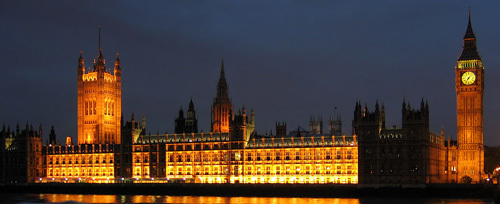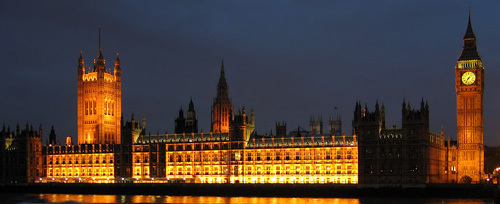
There can be few buildings in Europe to match the splendor of the Palace of Westminster. Millions of tourists, some of them off-worlders, flock to the landmark each year, even if few actually enter. But a couple of weeks back (and sorry to keep going on about it) Londonist did just that. Our tour of the houses of parliament inspired us to find out more about the architect, Charles Barry. Was this his only London building, and where did he find the inspiration to design this unique, labyrinthine complex? Well, our boots are made for stalking, and stalking they must do…

Three churches (1829)
Barry cut his architectural teeth designing churches, three of which can be found in Islington (each begun in 1829). None of the three are particularly significant works, but all hint at the gothic revival style that Barry would soon use to such powerful effect in Westminster. In fact, these are his only London buildings to show any hint of Victorian gothic, his other works all being in a classical style.
Two of the churches are twins: St John’s (left, near Archway), and St Pauls (right, on the junction of Balls Pond Road and Essex Road). If you scroll up, you can see how their towers are similar in shape to the Victoria Tower of the Palace of Westminster. The third church, and most imposing, is Trinity Church in Cloudesley Square (centre), which is clearly modeled on Kings College, Cambridge. When we visited, its twin turrets were coated in blue plastic mitts, as though to keep the church all snug through winter.

The Pall Mall clubs (1832, 1841)
Pall Mall remains a bastion of upper-class British society. Posh, mostly white carriers of the Y chromosome flock here to network at the numerous Gentlemen’s Clubs. Barry designed two of them: The Reform Club and the Travellers’.
The Reform is perhaps the most well-known gentleman’s club in the world, as a consequence of admitting one very famous, albeit fictional, member. It was in this building that Phileas Fogg made the notorious wager that he could master the globe in 80 days (presumably using budget airlines). Jules Verne’s adventure story has since been taken on by the likes of Michael Palin, Steve Coogan and a cartoon lion. The literary association continues today, and they even have their own blog. The club was founded by Whigs in 1838, as a gathering point for like-minded liberals who supported the Reform Act (legislation that greatly increased voting rights). Members have included Sir Arthur Conan Doyle, Winston Churchill and Menzies Campbell.
Next door (on the left of the image) is the Traveller’s Club, also designed by Barry. This is the oldest of the Pall Mall clubs and was created as a meeting point for well-off men with well-thumbed passports. Members have included the Duke of Wellington, Sir Ranulph Fiennes, John Simpson and Charles Barry himself.
Both clubs are in a similar ‘Renaissance Palace’ style, much influenced by Barry’s travels through Italy. The Traveller’s was built in 1832, and was the first building of its type in Britain. Barry’s sequel of 1841, however, is the better of the two. Taller, wider, stronger, and faced with Portland Stone, the Reform renders the Traveller’s almost anonymous.
Unfortunately, on our Stalk, the Reform was undergoing renovation, so rather than show you a mess of scaffolding, we’ve nicked the photo off of Wikipedia.

Royal College of Surgeons (1835)
This impressive, ionic-order building to the South of Lincoln’s Inn Fields was designed by Barry as a new home for the recently chartered Royal Society of Surgeons (the Latin text running across the façade says the charter was granted in 1800). The college contains one of London’s little-known and recently refurbished attractions: the Hunterian Museum of anatomical curiosities. This wonderful collection was bequeathed by 18th Century anatomist John Hunter, whose statue can be found across the road in the park. Unfortunately, the building took a direct hit in 1941, and the only original parts are the portico and library.

Old Treasury Building, Whitehall (1844-47)
Nobody ever notices this building as we’re all too busy looking at neighboring Downing Street for a glimpse of Blair or Brown. As the name implies, this was once the Treasury, before it moved to even more impressive headquarters just down the road. Today, the building mostly houses the Cabinet Office. What we see is mostly Barry’s work, but the building also contains sections from an earlier structure by John Soane. Surviving fragments of Henry VIII’s Whitehall Palace can also be found within, including tennis courts, turrets and a fireplace.

Bridgewater House, Cleveland Row (1847-50)
A stupendous pile, designed the house for the First Earl of Ellesmere, made all the more magnificent by its outlook onto Green Park. Where the Reform Club was a grander version of the Traveller’s, Bridgewater House is the Reform Club on steroids. Similar elements and proportions are used to stunning effect, especially when the stuccoed south-west face catches the sun. This was to be Barry’s last major London project. The half-complete Palace of Westminster, which was beginning to take shape a half-mile away on the banks of the Thames, had almost exhausted its designer.
Other work
41 Brook Street, a fairly typical Georgian townhouse, was Italianized by Barry in 1852. The front is elegant but fairly nondescript. Barry was also responsible for much of the layout of Trafalgar Square, most saliently the northern terrace and fountains.
How’s our stalking, and who should we stalk next? Let us know in the comments.




